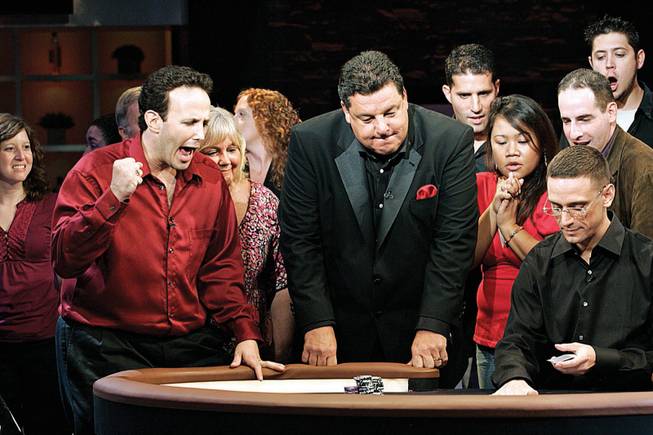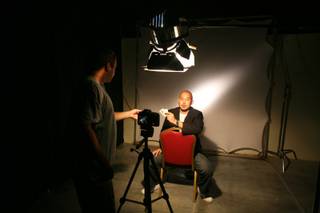
Adam Ehrlich, 33, of Philadelphia, left, celebrates a hand during NBC’s taping Sunday of “Face the Ace,” hosted by Steve Schirripa, center, at South Point.
Friday, Aug. 28, 2009 | 2 a.m.
‘Show Schedule
- 2 p.m. Sept. 12
- 5 p.m. Oct. 31
- 3 p.m. Nov. 14
- 3 p.m. Dec. 12
- 2:30 p.m. Jan. 2.
- (All shows on NBC)
- On the Web: www.face-the-ace.net
Sun Archives
Beyond the Sun
When “Face the Ace” made its premiere on NBC this month, its launch was accompanied by a drumbeat of provocative buzzwords.
Poker. Prime time. Network television.
The program, which blends head-to-head Texas hold ’em poker with elements of a game show, struggled in the ratings against its established competition, however.
When it returns Sept. 12, “Face the Ace” will occupy an afternoon time slot on NBC (Cox cable channel 3) and feature a slightly revised look that includes a louder, more active audience.
“We welcomed the suggestions and the criticism we received, and we’ve improved the show quite a bit,” said Jon Miller, executive vice president of NBC Sports. “This was more than a poker show for the serious player. This was also an entertainment show that reached out and brought in the casual poker fan.
“One of the things we needed to do was let them know about the excitement of heads-up poker. We didn’t do as good a job of that as we could have in the first couple of shows. We wanted to get the audience much more involved.”
During the taping of a new batch of “Face the Ace” episodes this weekend on a specially designed set on the floor of the South Point Arena, for instance, the crowd was encouraged to rush the stage and gather around the poker table for “all-in” confrontations.
After comprehensive editing, viewers will be made aware of players’ chip counts and the odds of each player’s chance of winning throughout a hand.
“It’s like displaying the score in an NFL game,” Miller said. “You’ll know the score at all times.”
Even so, “Face the Ace” will likely appeal to a mainstream audience rather than the hard-core poker fiends who might take a break from “multi-tabling” online to scrutinize every nuance of the myriad cable or late-night TV poker shows.
“We’re not going to make the poker junkies happy with this show,” Miller said. “They’re not going to be satisfied with what we’re doing here.
“But there are a lot of people who will come to this who are sports fans or casual poker fans, people who know the game of Texas hold ’em and understand the drama and the pressure. They’ll find it’s one of the fastest hours on TV.”
The basic format of “Face the Ace” remains the same. Contestants qualify through online tournaments, vying to win a trip to Las Vegas and a chance to compete on the program.
Once they are selected, contestants play a heads-up, winner-take-all “freeze-out” against a professional poker player from the show’s stable of “aces,” which includes Phil Ivey, Howard Lederer, Chris Ferguson, Erick Lindgren and other well-known pros.
The first match is for $40,000 in prize money. (Neither the contestant nor the pro puts up any money.) If the contestant wins, he can take the $40,000 and walk away or opt to risk it in a match against a second pro with $200,000 at stake.
If the contestant wins again, he can walk away or risk his winnings in a match against a third pro for the top prize of $1 million.
The pros are selected at random, adding a “Door Number 3” quality to the proceedings, with show host Steve Schirripa (“The Sopranos,” “The Secret Life of the American Teenager”) in the Monty Hall role.
“An ideal contestant is one who knows how to play, who’s talkative and maybe he has a little edge to him,” Schirripa said. “A lot of these guys have never been to Las Vegas before, never been on TV. It’s not for everyone. You’ve got the lights, you’ve got a crowd. Some people get a little shy.
“You’re up against some of the best poker players in the world, so you have to know what you’re doing. You can’t be a dummy.”
Relaxing in an impromptu “aces lounge” area at South Point during the taping, Lederer said the professionals engage in typical poker player behavior while waiting for their chance to appear on the show. They make bets among themselves on which pro will be chosen next. They needle each other about how particular hands played out.
Because their potential opponents are all unknown, likely amateur players, there’s not much else they can do to prepare.
“In terms of the dynamics of pros playing amateurs heads-up, for the pros it’s less ‘pokery,’ which is a word I’m making up,” Lederer said. “What I mean is, in poker, when you bring it down to its essence, you’re using a strategy and thinking on several levels. It’s strategy versus strategy, trying to figure out what the other guy is thinking and how to react.
“Here, it’s more like, OK, I just have to play solid and hope that works out. You don’t do a lot of the mind-game stuff you might do in a long match with another pro.”
Pregame jitters are not an issue for the “Face the Ace” pros, Lederer said.
“I don’t think anyone here gets nervous,” he said. “Remember, we’ve all played for $1 million of our own money before.”
Located South of the Strip, South Point is a hot spot frequented by locals. The hotel-casino is decorated in a Pacific Coast feel, with golds, reds and browns, mixing an island feel with the ambiance of Southern California.
Guests rooms feature 42-inch flat screen TVs, iPod docking stations and plush linens. Outside, the property features landscaped gardens, a hospitality to entertain poolside and a sand volleyball court.
When it comes to gaming, the South Point has more than 120,000 square feet of casino games, as well as a separate race books and sports books, a bingo and poker room. South Point also has some family friendly features, like a 64-lane bowling center, an arcade and a 16-screen movie theater.
Dining options range from an upscale meal at Michael's Gourmet to ice cream at Kate's Korner. The 24-hour Coronado Cafe is the perfect spot for a late-night craving, which include six midnight to 6 a.m. "graveyard" specials. Other restaurants include the Big Sur Oyster Bar, Don Vito's, Garden Buffet, Seattle's Best Coffee House and the Del Mar Deli.
One of South Points more unique features is the Equestrian Center and Arena, a first for Vegas. The Equestrian Center holds a variety of events, from college basketball to Championship Bull Riding.


Join the Discussion:
Check this out for a full explanation of our conversion to the LiveFyre commenting system and instructions on how to sign up for an account.
Full comments policy